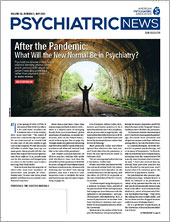A decade ago, Psychiatric News reporter Mark Moran wrote the article “Psychiatry Needs Eyes Wide Open About Environmental Issues.” I was one of the psychiatrists he interviewed. I’m pleased to say that a decade later, our eyes have opened wider, and we not only have recognized the impact of environmental issues, especially climate-related ones, but also are acting on what we see. One way of determining our progress so far is to review some of the quotes in that article.
“Never before have we had such an opportunity to slowly but surely improve the well-being of our entire planet. Psychiatry has a role to play, if only we become more involved,” I was quoted as saying.
To update this quote, we have to go backward in time first. Ecology consists of the interrelationships of organisms and their environments. Ecopsychiatry, therefore, is when psychiatry assesses the relationship of the environment to mental health. It was a focus of APA’s beginning in the late 1970s as it convened a task force relating the environment to mental health and illness, as described in an article for Psychiatric News titled “Is Ecopsychiatry a Specialty for the 21st Century?” This task force produced a bibliography of resources in 1979. At this time, APA was ahead of its time in recognizing and addressing ecopsychiatry. In the 1980s, research on seasonal affective disorder provided a relevant diagnosis and treatment focus in regard to our environment. The heyday of ecopsychiatry came in the mid-1990s, culminating in the publication of the book edited by the psychiatrist Arte Lundberg, M.D., in 1998 titled The Environment and Mental Health.
Then APA seemed to enter a period of hibernation on the environment. Perhaps it was because of the increased pressure of biological psychiatry and the business pressures of for-profit managed care. Then an awakening occurred as the climate warming and instability captured our imaginations.
After Lise Van Susteren, M.D., convened a meeting of concerned health and mental health professionals in Washington, D.C., in 2009 to discuss her concerns about the climate and environment, I established an informal group of psychiatrists called PEAK (Psychiatrists for Environmental Action and Knowledge) in the mid-2010s. That then disbanded as I, Dr. Van Susteren, and several colleagues began the Climate Psychiatry Alliance (CPA). After meeting with the steering committee of the CPA, APA responded first by creating the Caucus on Climate Change and Psychiatry and just recently approved the Committee on Climate Change and Mental Health.
Dr. Van Susteren is quoted by Mr. Moran in another article: “We have a duty to act—within our professional organizations, in our communities, offices, and homes.”
In essence, that is an ethical priority as stated in Section 7 of AMA’s Principles of Medical Ethics: “A physician shall recognize a responsibility to participate in activities contributing to the improvement of the community and the betterment of public health.”
APA itself has responded to environmental concerns with attention to sustainability in its new offices, replaced this year’s live Annual Meeting with an online one, and is holding governance and component meetings on Zoom. Perhaps when virtual meetings are no longer necessary due to the pandemic, a hybrid Annual Meeting that includes both on-site and virtual sessions could be held. This year’s Annual Meeting has the most sessions on climate change ever.
Mr. Moran then went on in the article to quote APA’s Office of Minority and National Affairs (OMNA, now the Division on Diversity and Health Equity) and its formation of the All Healers Mental Health Alliance in response to Hurricane Katrina. Among its goals were “to organize a long-term, culturally competent response to the mental health needs of people of the U.S., particularly people of color and people living in poverty affected by all hazards and disasters.”
The OMNA director at the time, Annelle Primm, M.D., conveyed that those living in poverty were disproportionately exposed to environmental hazards, as well as living close to toxic waste dumps and other toxic exposures. Similarly, it has become apparent that climate disasters disproportionately impact low-income and minority communities. Both are examples of systemic racism.
Robert Cabaj, M.D., the chair of APA’s Council on Advocacy and Government Relations a decade ago, commended the ecopsychiatry focus to date, as well as the work of APA’s Committee on Psychiatric Dimensions of Disaster and Physicians for Social Responsibility. He recommended the following: “I would encourage local efforts such as workshops or symposia at the district branch level, as well as seeking educational avenues at the APA meeting or Institute on Psychiatric Services. Given the very limited resources of APA and the focus of APA on patient care and advocacy, such educational efforts would be a practical approach.”
There was our rub at the time. Could APA and psychiatrists in general devote enough time and attention to address environmental and climate challenges if we had so much to do about patient care challenges? Of course, we must realize that a decade ago, there wasn’t the information we have now about how climate concerns were filtering into our clinical offices and psychotherapy. Recall, too, that about a decade ago was when burnout was starting to reach epidemic rates among psychiatrists and other physicians.
Now there are even more destructive environmental issues that we know impact mental health, such as COVID-19 and the risk of future pandemics. Nuclear devastation is still a possibility and could destroy much of the planet and/or alter the immediate climate. Toxins, especially lead poisoning, is a danger to mental health, especially in low-income and minority communities. Mass migration and urbanization have escalated. These issues and others are significantly influenced by human nature and behavior and could be deemed to be the focus of what could be called Planet Psychiatry.
Another way to get more focus on these environmental challenges without much time or expense is to expand our biopsychosocial model to a biopsychosocialeco one. That can be an antidote to limited or tunnel vision about the environment around us. ■
“Psychiatry Needs Eyes Wide Open About Environmental Issues” is posted
here.
“Is Ecopsychiatry a Specialty for the 21st Century?” is posted
here.

